1997 GMC SIERRA height
[x] Cancel search: heightPage 24 of 436
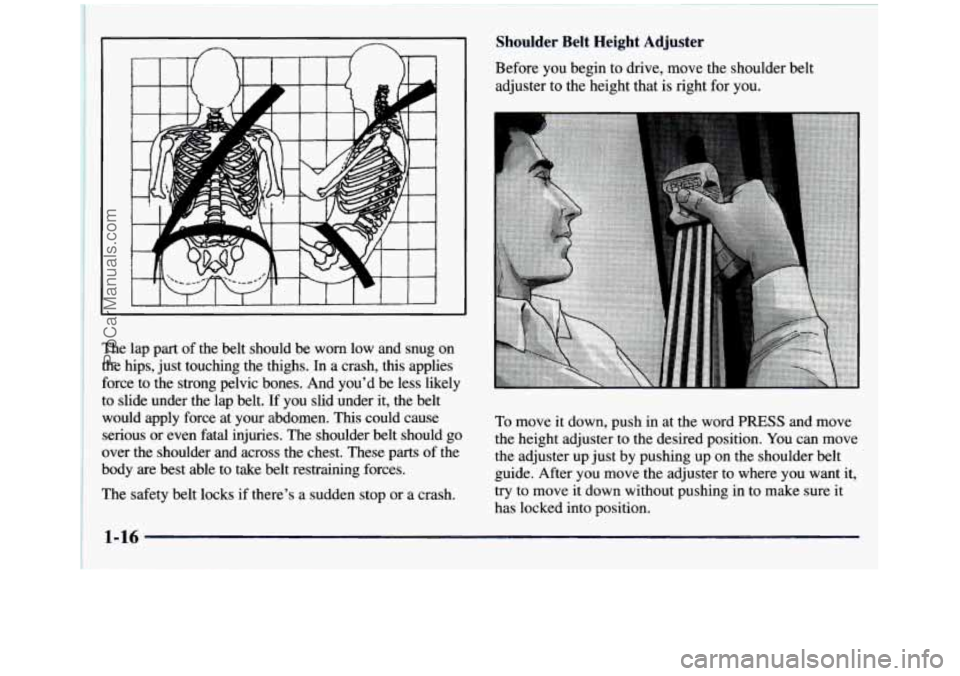
The lap part of the belt should be worn low and snug on
the hips, just touching the thighs.
In a crash, this applies
force to the strong pelvic bones. And you’d be less likely
to slide under the lap belt. If you slid under it, the belt
would apply force at your abdomen. This could cause
serious
or even fatal injuries. The shoulder belt should go
over the shoulder and across the chest. These parts of the
body are best able to take belt restraining forces.
The safety belt locks if there’s a sudden stop or a crash.
Shoulder Belt Height Adjuster
Before you begin to drive, move the shoulder belt
adjuster to the height that
is right for you.
To move it down, push in at the word
PRESS and move
the height adjuster to the desired position. You can move
the adjuster up just by pushing up on the shoulder belt
guide. After you move the adjuster to where you want it,
try to move it down without pushing in to make sure it
has locked into position.
1-16
ProCarManuals.com
Page 25 of 436
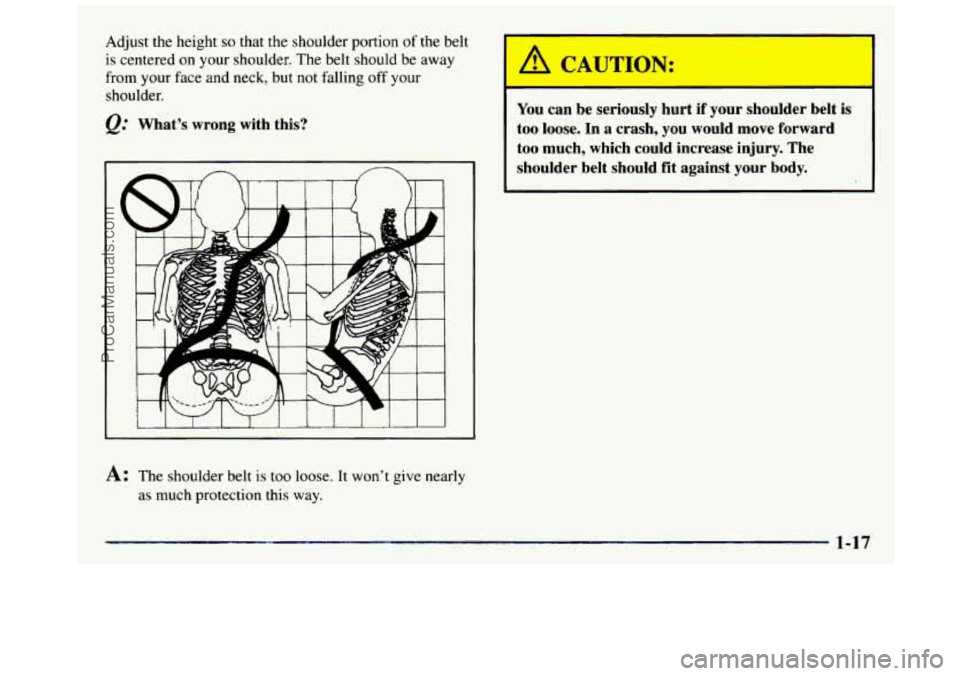
Adjust the height so that the shoulder portion of the belt
is centered on your shoulder. The belt should be away
from your face and neck, but not falling off your
shoulder.
&: What’s wrong with this?
A: The shoulder belt is too loose. It won’t give nearly
as much protection this way.
’ A CAUTION:
You can be seriously hurt if your shoulder belt is
too loose. In
a crash, you would move forward
too much, which could increase injury. The
shoulder belt should
fit against your body.
1-1 7
ProCarManuals.com
Page 39 of 436
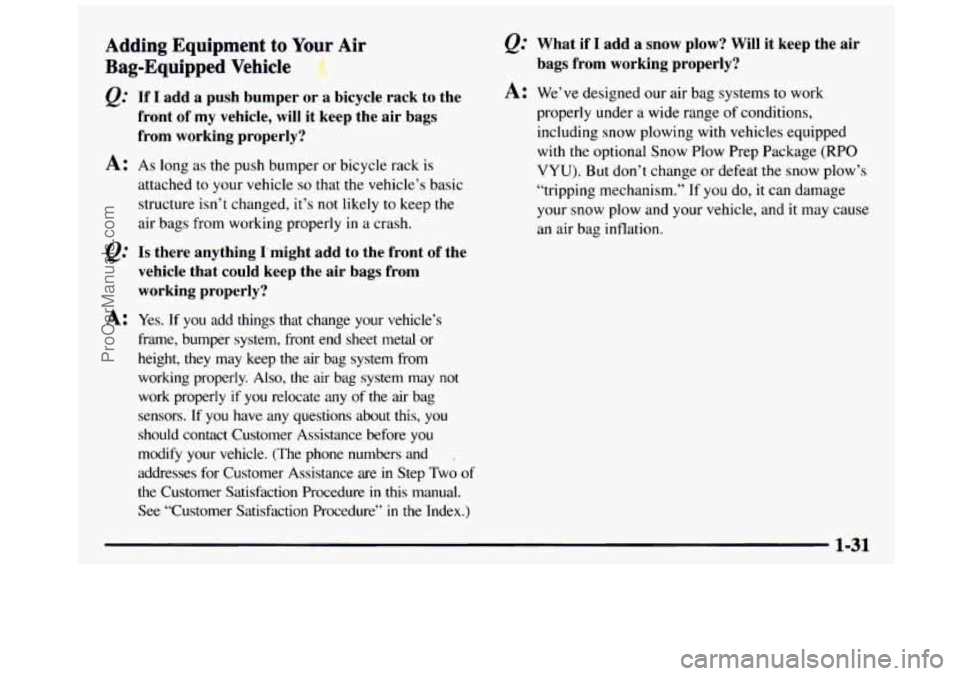
Adding Equipment to Your Air
Bag-Equipped Vehicle
&.’ If I add a push bumper or a bicycle rack to the
front
of my vehicle, will it keep the air bags
from working properly?
A: As long as the push bumper or bicycle rack is
attached to your vehicle so that the vehicle’s basic
structure
isn’t changed, it’s not likely to keep the
air bags from working properly
in a crash.
e.’ Is there anything I’might add to the front of the
vehicle that could keep the air bags from
working properly?
A: Yes. If you add things that change your vehicle’s
frame, bumper system, front end sheet metal or
height, they may keep
the air bag system from
working properly.
Also, the air bag system may not
work properly if you relocate any of the air bag
sensors.
If you have any questions about this, you
should contact Customer Assistance before
you
modify your vehicle. (The phone numbers and .
addresses for Customer Assistance are in Step Two of
the Customer Satisfaction Procedure in this manual.
See “Custotner Satisfaction Procedure”
in the Index.)
e.’ What if I add a snow plow? Will it keep the air
bags from working properly?
A: We’ve designed our air bag systems to work
properly under a wide range
of conditions,
including snow plowing with vehicles equipped with the optional Snow Plow Prep Package (RPO
VYU). But don’t change or defeat the snow plow’s
“tripping mechanism.”
If you do, it can damage
your snow plow and your vehicle, and
it may cause
an air bag inflation.
1-31
ProCarManuals.com
Page 314 of 436
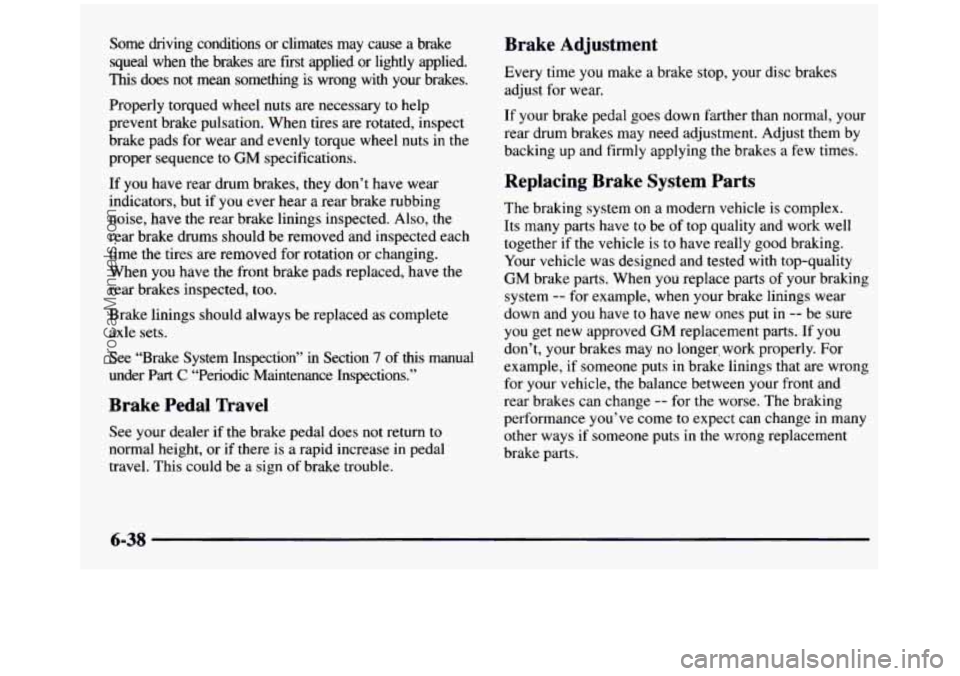
Some driving conditions or climates may cause a brake
squeal when the brakes are first applied or lightly applied.
This does not mean something is wrong with your brakes.
Properly torqued wheel nuts are necessary to help
prevent brake pulsation. When tires are rotated, inspect
brake pads for wear and evenly torque wheel nuts in the
proper sequence
to GM specifications.
If you have rear drum brakes, they don’t have wear
indicators, but if you ever hear
a rear brake rubbing
noise, have the rear brake linings inspected. Also, the
rear brake drums should be removed and inspected each
time the tires are removed for rotation or changing.
When you have the front brake pads replaced, have
the
rear brakes inspected, too.
Brake linings should always be replaced as complete
axle sets.
See “Brake System Inspection” in Section 7 of this manual
under Part
C “Periodic Maintenance Inspections.”
Brake Pedal Travel
See your dealer if the brake pedal does not return to
normal height, or
if there is a rapid increase in pedal
travel. This could be a sign
of brake trouble.
Brake Adjustment
Every time you make a brake stop, your disc brakes
adjust for wear.
If your brake pedal goes down farther than normal, your
rear drum brakes may need adjustment. Adjust them by
backing up and firmly applying the brakes a few times.
Replacing Brake System Parts
The braking system on a modern vehicle is complex.
Its many parts have to be of top quality and work well
together
if the vehicle is to have really good braking.
Your vehicle was designed and tested with top-quality
GM brake parts. When you replace parts of your braking
system
-- for example, when your brake linings wear
down and you have to have new ones put in -- be sure
you get new approved
GM replacement parts. If you
don’t, your brakes may no longer. work properly. For
example, if someone puts
in brake linings that are wrong
for your vehicle,
the balance between your front and
rear brakes can change
-- for the worse. The braking
performance you’ve come to expect can change in many
other ways
if someone puts in the wrong replacement
brake parts.
ProCarManuals.com
Page 334 of 436
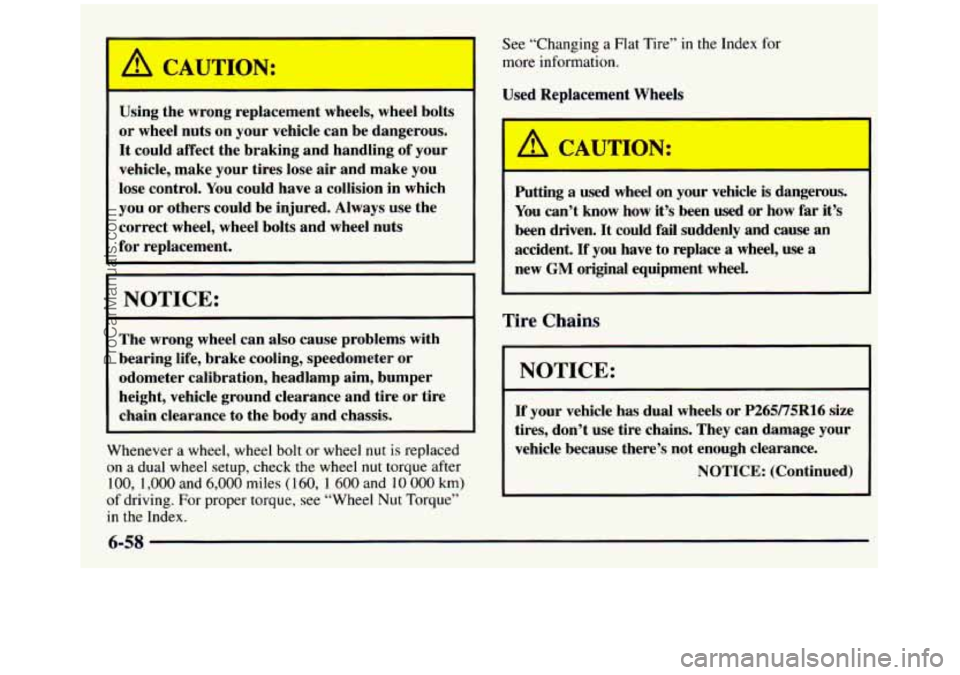
I a CAUTION:
Using the wrong replacement wheels, wheel bolts
or wheel nuts on your vehicle can be dangerous.
It could affect the braking and handling of your
vehicle, make your tires lose air and make you
lose control.
You could have a collision in which
you or others could be injured. Always use the
correct wheel, wheel bolts and wheel nuts
for replacement.
I NOTICE:
The wrong wheel can also cause problems with
bearing life, brake cooling, speedometer or
odometer calibration, headlamp aim, bumper
height, vehicle ground clearance and tire or tire
chain clearance
to the body and chassis.
Whenever a wheel, wheel bolt or wheel
nut is replaced
on a dual wheel setup, check the wheel
nut torque after
100, 1,000 and 6,000 miles ( 160, 1 600 and 10 000 km)
of driving. For proper torque, see “Wheel Nut Torque’’
in the Index. See
“Changing a
Flat Tire” in the Index for
more information.
Used Replacement Wheels
~
Putting a used wheel on your vehicle is dangerous.
You can’t know how it’s been used or how far it’s
been driven. It could fail suddenly and
cause an
new
GM original equipment wheel.
~ accident. If you have to replace a wheel, use a
Tire Chains
I NOTICE:
If your vehicle has dual wheels or P26975R16 size
tires, don’t use tire chains. They can damage
your
vehicle because there’s not enough clearance.
NOTICE: (Continued)
6-58
ProCarManuals.com
Page 430 of 436
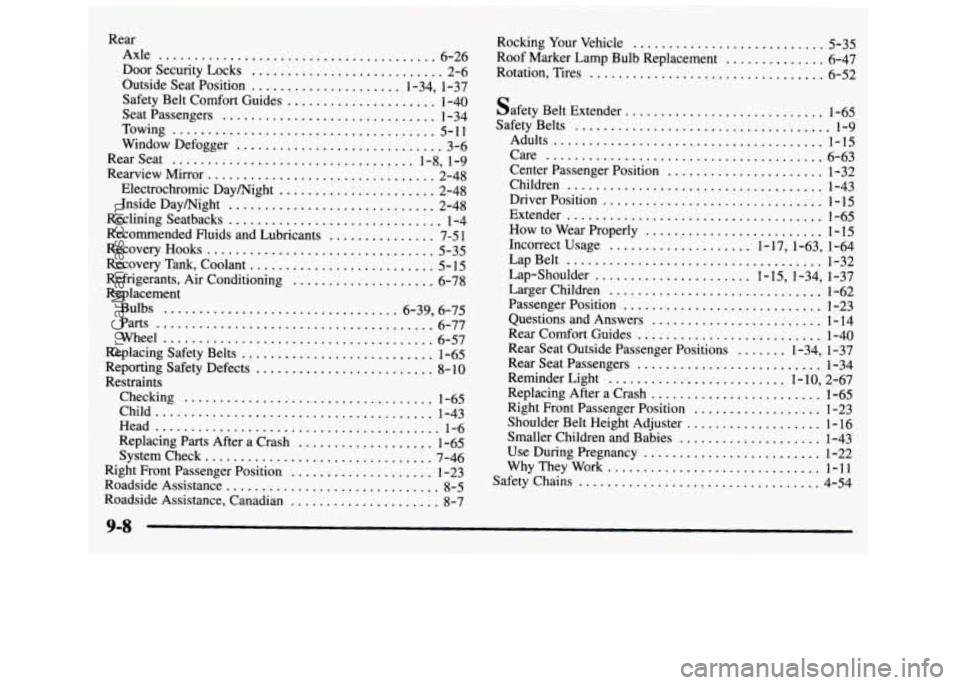
Rear Axle
......................................-'6-26
DoorSecurityLocks ........................... 2-6
Outside Seat Position ..................... 1-34, 1-37
Safety Belt Comfort Guides
..................... 1-40
Window Defogger
............................. 3-6
Electrochromic Daymight ...................... 2-48
Inside Daymight
............................. 2-48
Reclining Seatbacks
.............................. 1-4
Recommended Fluids and Lubricants
............... 7-5 1
Recovery Tank, Coolant
.......................... 5- 15
Refrigerants. Air Conditioning
.................... 6-78
Seatpassengers
,............................. l-34
Towing ..................................... 5-11
RearSeat
.................................. 1-8, 1-9
Rearview Mirror 2-48
................................
RecoveryHooks ................................ 5-35
Replacement
Bulbs
................................. 6-39, 6-75
Parts
....................................... 6-77
Wheel
...................................... 6-57
Replacing Safety Belts ........................... 1-65
Reporting Safety Defects
......................... 8- 10
Restraints Checking
................................... l-65
Head ........................................ l-6
7-46
Child
....................................... 1-43
Replacing Parts After
a Crash ................... 1-65
Right Front Passenger Position
.................... 1-23
Roadside Assistance .............................. 8-5
Roadside Assistance. Canadian ..................... 8-7
System Check
................................
Rocking
Your Vehicle ........................... 5-35
Roof Marker Lamp Bulb Replacement .............. 6-47
Rotation. Tires
................................. 6-52
safety Belt Extender ............................ 14-55
Center Passenger Position
...................... 1-32
How
to Wear Properly ......................... 1-15
Incorrect Usage
.................... 1-17? 1-63, 1-64
Lap-Shoulder
...................... 1-15. 1-34. 1-37
Passenger Position
............................ 1-23 Questions and Answers ........................ 1-14
Rear Comfort Guides
.......................... 1-40
Rear Seat Outside Passenger Positions
....... 1-34. 1-37
Rear Seat Passengers
.......................... 1-34
Reminder Light
.......................... 1-10, 2-67
Replacing After
a Crash ........................ 1-65
Right Front Passenger Position
.................. 1-23
Shoulder Belt Height Adjuster
................... 1-16
Smaller Children and Babies
.................... 1-43
Use During Pregnancy ......................... 1-22
Why They Work .............................. 1-11
Safety Belts .................................... 1-9
Adults
.........,............................ l-15
Care 6-63
Children .................................... 1-43
Driver Position ............................... 1-15
Extender
.................................... 1-65
.......................................
.................................... Lap Belt 1-32
Larger Children
.............................. 1-62
Safety Chains
.................................. 4-54
9-8
ProCarManuals.com
Page 431 of 436
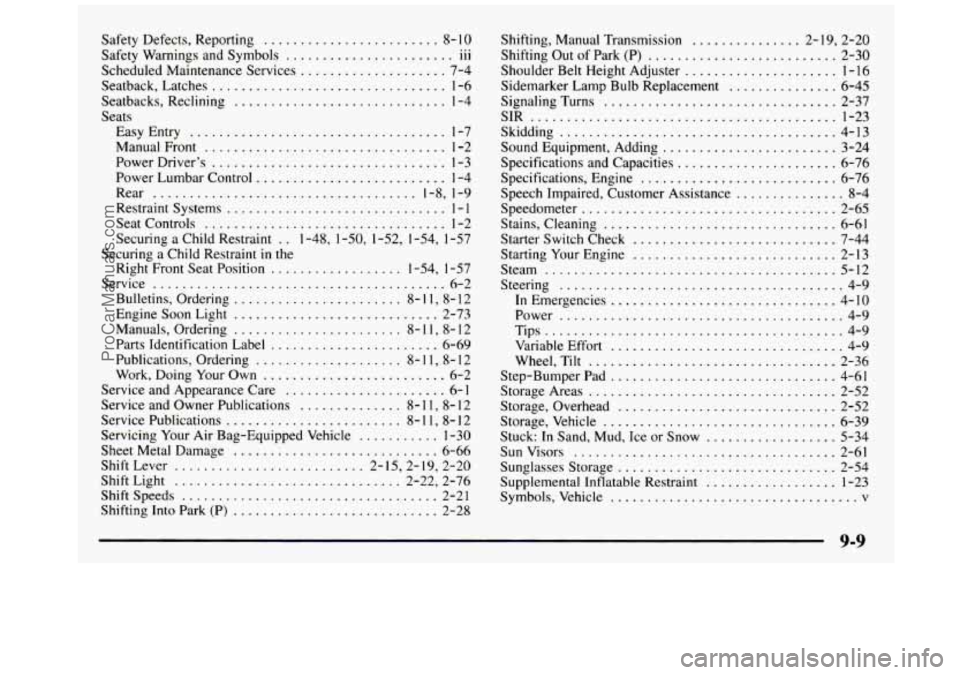
Safety Defects. Reporting ........................ 8- 10
Safety Warnings and Symbols ....................... 111
Scheduled Maintenance Services .................... 7-4
Seatback. Latches
................................ 1-6
Seatbacks. Reclining
............................. 1-4
Seats
EasyEntry
................................... 1-7
ManualFront
................................. 1-2
Power Driver’s
................................ 1-3
Power Lumbar Control
.......................... 1-4
Rear
.................................... 1.8. 1.9
Restraint Systems
.............................. I . 1
Seatcontrols ................................. 1-2
Securing a Child Restraint
. . 1.48. 1.50. 1.52. 1.54. 1-57
Securing a Child Restraint
in the
Right Front Seat Position
.................. 1.54. 1-57
Service
........................................ 6-2
Bulletins. Ordering
....................... 8- 1 1. 8. 12
EngineSoonLight
............................ 2-73
Manuals. Ordering
....................... 8- 11. 8. 12
Parts Identification Label
....................... 6-69
Publications. Ordering
.................... 8- 1 1. 8. 12
Work. Doing Your Own
......................... 6-2
Service and Appearance Care ...................... 6- 1
Service and Owner Publications .............. 8- 1 1. 8- 12
Service Publications
........................ 8- 1 1. 8. 12
Servicing Your Air Bag-Equipped Vehicle
........... 1-30
Sheet Metal Damage
............................ 6-66
Shift Lever .......................... 2.15.2.19. 2.20
Shift Light
............................... 2.22. 2.76
Shifting Into Park (P)
............................ 2-28
...
Shiftspeeds ................................... 2-21 Shifting.
Manual Transmission
............... 2- 19. 2-20
Shifting Out of Park
(P) .......................... 2-30
Shoulder Belt Height Adjuster
..................... 1-16
Sidemarker Lamp Bulb Replacement
............... 6-45
SignalingTurns
................................ 2-37
Skidding
...................................... 4-13
Sound Equipment. Adding
........................ 3-24
Specifications and Capacities
...................... 6-76
Specifications. Engine
........................... 6-76
Speech Impaired. Customer Assistance
............... 8-4
Speedometer
................................... 2-65
Stains. Cleaning
................................ 6-61
Starter Switch Check
............................ 7-44
Starting Your Engine
............................ 2-13
Steam
........................................ 5-12
Steering
....................................... 4-9
In Emergencies ............................... 4-10
Power
....................................... 4-9
Tips
......................................... 4-9
Variable Effort
................................ 4-9
Wheel. Tilt
.................................. 2-36
Step-BumperPad
............................... 4-61
StorageAreas
.................................. 2-52
Storage. Overhead
.............................. 2-52
Storage. Vehicle
................................ 6-39
Stuck: In Sand. Mud. Ice or Snow
.................. 5-34
Sunvisors
.................................... 2-61
Sunglasses Storage
.............................. 2-54
Supplemental Inflatable Restraint
.................. 1-23
Symbols. Vehicle
.................................. v
SIR .......................................... 1-23
ProCarManuals.com